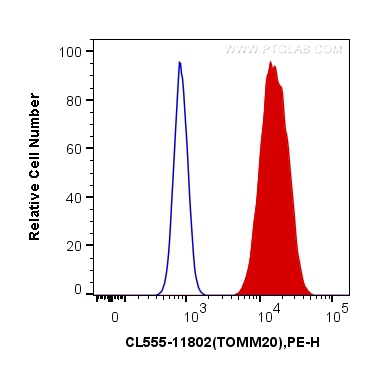验证数据展示
经过测试的应用
| Positive IF/ICC detected in | HepG2 cells |
| Positive FC (Intra) detected in | HepG2 cells |
推荐稀释比
| 应用 | 推荐稀释比 |
|---|---|
| Immunofluorescence (IF)/ICC | IF/ICC : 1:50-1:500 |
| Flow Cytometry (FC) (INTRA) | FC (INTRA) : 0.40 ug per 10^6 cells in a 100 µl suspension |
| It is recommended that this reagent should be titrated in each testing system to obtain optimal results. | |
| Sample-dependent, Check data in validation data gallery. | |
产品信息
CL555-11802 targets TOM20 in IF/ICC, FC (Intra) applications and shows reactivity with human, mouse, rat samples.
| 经测试应用 | IF/ICC, FC (Intra) Application Description |
| 经测试反应性 | human, mouse, rat |
| 免疫原 |
CatNo: Ag2378 Product name: Recombinant human TOM20 protein Source: e coli.-derived, PGEX-4T Tag: GST Domain: 1-145 aa of BC000882 Sequence: MVGRNSAIAAGVCGALFIGYCIYFDRKRRSDPNFKNRLRERRKKQKLAKERAGLSKLPDLKDAEAVQKFFLEEIQLGEELLAQGEYEKGVDHLTNAIAVCGQPQQLLQVLQQTLPPPVFQMLLTKLPTISQRIVSAQSLAEDDVE 种属同源性预测 |
| 宿主/亚型 | Rabbit / IgG |
| 抗体类别 | Polyclonal |
| 产品类型 | Antibody |
| 全称 | translocase of outer mitochondrial membrane 20 homolog (yeast) |
| 别名 | TOMM20, KIAA0016, MAS20, MOM19, tom 20 |
| 计算分子量 | 145 aa, 16 kDa |
| 观测分子量 | 16 kDa |
| GenBank蛋白编号 | BC000882 |
| 基因名称 | TOM20 |
| Gene ID (NCBI) | 9804 |
| RRID | AB_2919606 |
| 偶联类型 | CoraLite®555 Fluorescent Dye |
| 最大激发/发射波长 | 557 nm / 570 nm |
| 形式 | Liquid |
| 纯化方式 | Antigen affinity purification |
| UNIPROT ID | Q15388 |
| 储存缓冲液 | PBS with 50% glycerol, 0.05% Proclin300, 0.5% BSA, pH 7.3. |
| 储存条件 | Store at -20°C. Avoid exposure to light. Stable for one year after shipment. Aliquoting is unnecessary for -20oC storage. |
背景介绍
Background
TOM20 (KIAA0016) belongs to the Tom family. It is a subunit of the mitochondrial import receptor (PMID: 7584026), whose main role is to translocate cytosolically synthesized mitochondrial proteins through the outer mitochondrial membrane and subsequently facilitate the movement of proteins into the TOM40 translocation pore complex (PMID: 21173275).
What is the molecular weight of TOM20?
It is a short 16.3 kDa protein containing several highly conserved regions, including the transmembrane segment, the ligand-binding domain, and flexible segments at the N terminus and the C terminus of the protein crucial for its function (PMID: 15733919).
What is the subcellular localization of TOM20?
It specifically localizes in the mitochondrial outer membrane. In malignant cells, strong granular staining in the cytoplasm has been observed.
What is the tissue specificity of TOM20?
It is ubiquitously expressed in various tissues, with a particularly high expression in the brain, thyroid, and pancreas.
What is the function of TOM20 in the mitochondrial membrane?
Mitochondrial preproteins are generally synthesized in the cytoplasm with signal or targeting sequences, which are recognized by specific receptors on the outer mitochondrial membrane. TOM20, as one of the components of the TOM40 complex, specifically recognizes pre-sequences on target proteins or their unfolded forms. In addition to its translocase activity, TOM20 may act as a chaperone preventing these proteins from aggregation at the surface of mitochondria (PMID: 14699115).
What is TOM20's involvement in disease?
Diseases linked to the misregulation of TOM20 include Perry Syndrome and neurodegeneration with brain iron accumulation 2A. Numerous studies also associate deregulation of TOM20 with an array of mitochondrial dysfunctions and mitophagy defects (PMIDs: 30254015, 30160596).
实验方案
| Product Specific Protocols | |
|---|---|
| FC protocol for CL555 TOM20 antibody CL555-11802 | Download protocol |
| IF protocol for CL555 TOM20 antibody CL555-11802 | Download protocol |
| Standard Protocols | |
|---|---|
| Click here to view our Standard Protocols |



